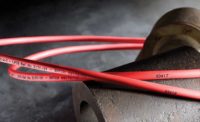When I was a lad, the family car only had an AM radio, which was just fine with my father. All he wanted was to listen to the ballgame. FM radio? Tape player? Man, those were luxuries!
My how times have changed. Today’s cars are equipped with satellite radio and navigation, DVD players, Bluetooth, Wi-Fi, back-up cameras, on-board diagnostics, lane-departure warning systems, collision avoidance systems and hands-free parallel parking systems. And, coming soon…autonomous driving. What in the world?
Whether my pop likes it or not, today’s cars contain a host of electronics. But, all those gizmos pose a challenge to automotive OEMs. Clear signals and high-speed data transmission are essential to their operation. At the same time, cost, weight and flexibility are concerns, so shielded cabling is not option.
To solve the problem, automakers are turning to a concept that originated with Alexander Graham Bell: the unshielded twisted pair (UTP) cable. UTP cables are a type of wiring in which two conductors of a single circuit are twisted together for the purposes of canceling out cross-talk and electromagnetic interference (EMI) from external sources.
UTP cables are best known for their use in telephone systems, security systems and Ethernet networks. However, automotive OEMs are increasingly using UTP-based Ethernet networks to wire up multiple electronic systems in high-tech luxury vehicles. By eliminating cumbersome, shielded cabling, automotive Ethernet networks can significantly reduce connectivity costs and cabling weight. In fact, market research firm Tecnavio predicts that the global automotive Ethernet market will grow at a cumulative annual rate of 42 percent from 2017 to 2021.
Fortunately for harness assemblers, a new generation of equipment is now available to create UTP cables. Options range from basic benchtop units to fully automated systems that cut, strip, terminate, twist and tape UTPs without human intervention.
Back to Basics
The Eraser Co. offers a variety of benchtop machines for making UTPs.
The Model WT40 automatically twists two or more wires at lengths up to 20 feet. The unit can twist together several small plain or terminated wires and is programmable to a desired number of twists per inch. Twist quantity can be up to 9,999 twists per cycle. The maximum material bundle cannot exceed the equivalent of three 14 AWG insulated wires. Twisting speed can be set from 0 to 26 turns per second. The machine requires a holding or clamping device custom-made for each application.
Like the WT40, the WT200 can twist two or more wires up to 20 feet in length. It can handle a bundle of wire up to the equivalent of two 16 AWG insulated wires. The WT200 has a reversible motor that enables it to twist or untwist in either direction. Twisting speed can be adjusted from 0 to 26 turns per second. The machine is supplied with three sizes of wire entry guides (0.125, 0.1875 and 0.25 inch) and flexible tubes for wire clamping. The tubing prevents marking or deformation to stripped conductors or insulation.
The WT300 is a variation of the WT200 designed for bare wires. It is supplied with one wire entry guide and a set of steel clamp jaws that firmly grip magnet wire, fine wire and slippery wire.
Going Automatic
For greater throughput and higher precision, harness assemblers will want an automated standalone machine.
“You want the twisting process to be as automated as possible for consistency,” says Patrick Moroney, product marketing manager for Komax Corp. “If you’re making thousands of twisted pairs, you want the process to be tightly controlled. The pitch must be as consistent as possible. If it varies even by a millimeter, you may get impedance issues.”
One example of an automated standalone machine is the BT 188 T from Komax. The operator inputs the final twisted length, the pitch length, the wire cross section, the outer wire diameter, and lengths of the open ends. The machine then automatically calculates the required cut length. This minimizes the amount of test material consumed when setting up a new product. The controller can store 1,200 programs.
The machine can twist two to four wires. It can create twisted pairs ranging from two 28 AWG wires to two 11 AWG wires. It can also create three or four wire assemblies (28 to 14 AWG).
Pitch length can be set from 0.31 to 1.97 inch. The open ends can range in length from 0.98 to 7.48 inches. The final length of the twisted pair can be as short as 7.87 inches or as long as 37 feet with optional extensions.
A unique feature of the machine is an integrated spot-taping unit. Once the wires have been twisted together, the unit wraps each end with cloth or PVC tape to keep the pair from unwinding during transport, assembly and installation.
Another option is the WireTwister 3300 D from Schleuniger Inc. For maximum throughput, the machine has two twisting heads. While one head is twisting a set of wires, the operator can load the next set of wires onto the second head. Each head twists the wires with constant tension control. A programmable, automatic wire relaxing sequence ensures repeatable quality. At the end of the twisting process, the wire holders automatically eject the twisted cable into an integrated stacking channel.
A touch-screen user interface makes entering and editing process settings quick and easy. The machine can store 1,000 twist programs. The moveable carriage holding the wire holders can be set in a precise position for the initial wire length. Automatic moveable safety shields in front of the rotating wire holders ensure safe and comfortable operation.
Thanks to its modular design, the machine can be configured in lengths ranging from 5.9 to 37.4 feet, in 7.8-foot increments.
The machine can make UTPs ranging from two 26 AWG wires to two 12 AWG wires. The length of the untwisted ends can be set from 1.18 to 3.94 inches. The pitch can range from 0.39 to 1.97 inches. Twisting speed ranges from 800 to 2,000 rpm. The machine can be programmed to provide counter rotation at the end of the twisting cycle to reduce untwisting and keep the pitch stable.
Tips and Tricks
Creating a twisted pair may seem straightforward, but there’s more to the process than simply spinning two wires together.
For one thing, the pitch, or twist rate, will vary depending on the wire and the application. During initial setup for production, harness assemblers may find that creating a UTP with the specified pitch may require some trial and error.
“You want to start with good quality wire,” advises Moroney. “One thing you have to figure out is how much of ‘overtwist’ is needed so that after the assembled pair is released from the twisting mechanism, the wires stay tightly wound. That’s very dependent on the elastic properties of the wire. Some wire requires less overtwist than others.
“It’s tricky. Too much overtwist, you can damage the wires. Not enough, and it will unwrap.”
Both wires should be as close to the same length as possible prior to twisting. “If one is even a little bit longer, it will affect impedance,” says Moroney.
The open ends of the twisted pair should be as short as possible—no longer than 30 millimeters. “Eyes” or “bubbles”—spots where the two wires don’t fit tightly together—are a no-no. “If you can see any light between the wires, that’s a problem. You want them to be tightly wound,” says Moroney.
Machine Restores Twist to Stranded Conductors
Have you ever stripped a wire only to have the conductor strands unravel and spread? The frayed end is difficult or impossible to terminate or insert into a connector block.
The Model 25F rotary wire twister from Carpenter Manufacturing Co. Inc. quickly restores a twist to stripped stranded conductors from 13 to 24 AWG. The machine is fast and easy to use: Simply insert the stripped wire into the rotating guide sleeve and withdraw. Twist lengths from 0.25 to 1 inch are controlled using spacers located inside the guide sleeve.
The machine can also twist two stripped hook-up wires together neatly and efficiently.
For more information, call Carpenter Manufacturing at 315-682-9176 or visit www.carpentermfg.com.







